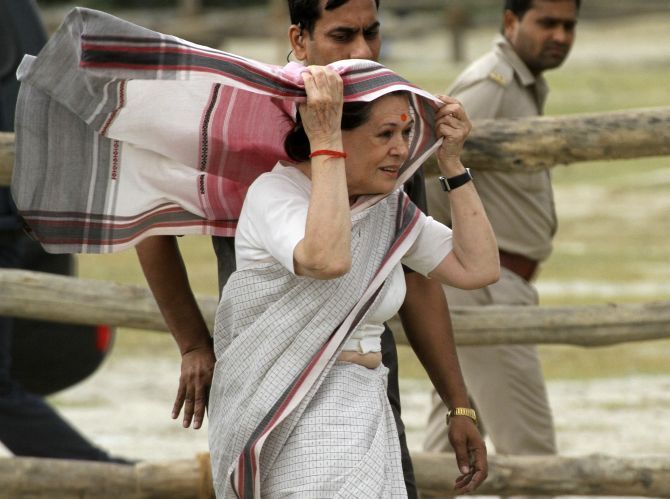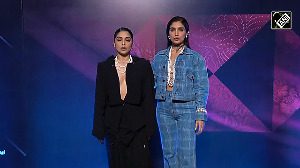After handing over the reins of the Congress to her son, the 71-year-old MP may have time to pursue her other interests, but many believe that she will continue to play the role of a mentor. Sanjeev Chopra reports

Sonia Gandhi, who on Saturday handed over the reins of the Congress to her son, Rahul Gandhi, was once seen as an unlikely heir to the Gandhi political legacy, but crowned her innings by becoming the longest serving president of India’s grand old party.
Her exit was as subdued as her entry was spirited.
“I am going to retire,” the 71-year-old Member of Parliament told reporters on Friday, sending party leaders into a tizzy and hastening to explain that she was not quitting politics.
But Indira Gandhi’s daughter-in-law is known to spring surprises. If her successor was often described as the reluctant heir of the family, she was even more loath to take up a political role.
Legend has it that when Congress leaders pressed Rajiv Gandhi to occupy the prime minister’s chair after the assassination of his mother Indira Gandhi, Sonia Gandhi begged him not to, fearful about her family’s safety.
Seven years later, when he was killed, she turned away when party leaders urged her to lead the Congress.
It was another seven years later, when the party was in tatters at the Centre and in power only in four states, that she agreed to pick up the reins of the party. She was persuaded to do so after senior leaders left the Congress and set up their own regional outfits.
When the Congress was in a shambles, Sonia Gandhi -- described by sections of the media as the most powerful woman in India -- steered it to victory in 2004, ousting the National Democratic Alliance.

That wasn’t all.
When it appeared that she would occupy the highest office in South Block, she told the surprised media that she had chosen Manmohan Singh as the prime minister of the United Progressive Alliance government.
Today, party leaders look back at her presidency with pride, hailing unity and strength as the hallmarks of her record breaking 19-year tenure.
Sonia Gandhi took a back seat after several rounds of illness recently, for which she had be hospitalised.
She exits active Congress politics on a high note and as one of the tallest leaders of the party in recent years.

Photograph: Reuters
Sonia Gandhi’s sharpest weapon was her silence. She spoke little, and seldom in public, but wielded enormous power in the Congress.
In cotton saris that reminded old-timers of her mother-in-law, she has over the years addressed public rallies in her accented Hindi, suitably blunting the Bharatiya Janata Party’s campaign against her Italian roots.
Under her stewardship, the Congress led the Centre for two terms from 2004 to 2014 and returned to power in a host of states. The then party president achieved this by successfully stitching electoral alliance with like-minded parties.
UPA-1 and UPA II were fine examples of Sonia Gandhi’s ability to bring non-BJP forces together. Her prediction of the Congress returning at the Centre on its own, made at the party’s Pachmarhi conference, never came true though.
That said, Gandhi braved tremendous odds to earn her place in Indian politics, as she conquered the limitations of language and her foreign origin to win the hearts of people.

Born to Italian parents in Lusiana, Vicenza (Italy), on December 9, 1946, Gandhi met Rajiv Gandhi in England where she was studying. The young language student and the son of then Indian prime minister were married 1968.
Contemporary history recalls how she cradled her mother-in-law’s body after she was gunned down by her bodyguards, and later tried to persuade her husband not to take up the prime minister’s post.
After Rajiv Gandhi’s assassination in May, 1991, she shunned active politics, but after repeated cajoling by Congress leaders took the primary membership of Congress in 1997. Amid consequent widespread demands from rank and file to lead a shaky party, she entered public life in 1998, a move that was widely and loudly welcomed in the party.
She was first elected as an MP from Amethi in 1999, following which she became the Leader of the Opposition in the Lower House. She later shifted to Rae Bareli to accommodate her son in Amethi.

In 2004, she led the electoral campaign of her party which secured the largest number of seats and formed a coalition government.
When she nominated Singh as the prime minister, her standing went up by several notches. Her supporters called it an act of sacrifice while some saw it as a political masterstroke.
Gandhi, however, continued to wield power in the party as the chairperson of the UPA and the leader of the Congress party in Parliament, leading its strategy inside and outside the Houses.
She also introduced the concept of National Advisory Council, a forum that made periodic recommendations to the government and often dubbed as a “dual power centre” by the opposition. As its chairperson, Gandhi took up issues related to environment, gender, empowerment of the disadvantaged and right to information.
At a personal level, Sonia Gandhi has authored two books on her husband, Rajiv and Rajiv’s World, and has edited two volumes of letters exchanged between Jawaharlal Nehru and Indira Gandhi.

Her other interests include reading, Indian art -- contemporary, classical as well as tribal -- handlooms and handicrafts and music. She has a diploma in conservation of oil paintings from the National Museum in New Delhi.
While she may find time to pursue her passions now, her son is set for tough times with the Congress at a historic electoral low in its entire history. In power only in five states now, and facing difficult elections in Gujarat and Himachal Pradesh, the Congress, everyone agrees, is facing its worst existential crisis ever.
Congress leaders feel that she will continue to play the role of a mentor to the party for times to come. She may also continue as the chairperson of the Congress Parliamentary party and the UPA alliance.
As a Congress leader says, “Even now, Rahul Gandhi is bound to consult his mother on every important party related decision he takes.”











 © 2025
© 2025